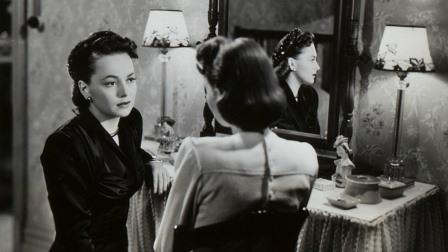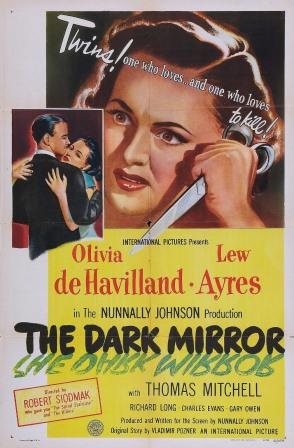When he called her “killer”… and took her twin in his arms… Did he know which was which?
What’s better than an Olivia de Havilland picture? How about a picture with not one, but two Olivia’s – both named de Havilland?
You need look no farther than 1946’s The Dark Mirror, which stars Olivia in dual roles as sisters Ruth and Terry Collins. Well directed by stalwart director Robert Siodmak (been watching his work a lot lately), the story opens with a doctor killed in his apartment. Dimwitted but strangely prosaic gumshoe Lt. Stevenson (Thomas Mitchell)almost immediately zones in on Terry Collins as his key suspect, with several eyewitnesses seeing her around the scene of the crime. Only later does Mitchell learn that Terry has an identical twin sister Ruth. Both seem to have airtight alibis but he’s sure that one of them is the culprit.
When Stevenson threatens to simply charge both of them with suspicion of murder and obstruction of justice, the sister throw down a good legal defense (coupled with a lawyer) and he is forced to back down, at least momentarily. Stevenson is an afterthought mostly in the picture after this, as psychiatrist Scott Elliott (Lew Ayres) bubbles to the front.
For some strange reason, Elliott convinces the two sisters to subject themselves to a battery of tests as part of his pet project to research the interaction of twins. There’s quite a bit of typical (for the era) Freudian mumbo-jumbo but that’s not the point. With the sisters being basically ‘off the hook’ at this point why would they subject themselves to this? They do mention a need for money, but as they have enough for monogrammed accessories and clothing, that wouldn’t seem to be enough to risk a trip to the big house.
Throughout the picture simmers often but never really boils over with suspense until the final climax. The story is definitely engaging enough- though still lacking a bit of believability- but the real attraction of the picture is its star, Olivia de Havilland.

Though not one of her more popular films, The Dark Mirror is another example of how, when left to her own devices, de Havilland picked more challenging and frankly better roles for herself than Warner Brothers did. Though the evil twin motif has been beaten to death, in most cases the evil twin is blatantly different from the ‘good’ twin. de Havilland’s performance here is much more subtle and doubtless drew to some extent from her relationship with her sister Joan Fontaine. Though not needed for the discerning viewer, for most of the picture the sisters wear gaudy necklaces with their names emblazoned on them for all to see.
What attentive viewers will notice is the differences de Havilland puts into each sister, making each their own distinct character. Only one sister is left handed. Only one sister smokes. Less obvious are the differences in tone she gives to each sister, with one being slightly quicker and more agitated than the other. One’s almost shrill while the other’s dialogue almost exudes honesty.
Another highlight of The Dark Mirror is the technical expertise in pulling off having two Olivia’s interact with each other on screen. Given that the film came out in 1946, it’s extremely well done- even though it is easy to see how it was done for the most part.
The Dark Mirror is definitely an enjoyable film driven by an outstanding performance in the lead role. Though a noiresque film, its lack of a brooding and angst ridden bad guy or a plethora of deep angular shadows make it hard to label as a definitive noir picture.
[embedyt] https://www.youtube.com/watch?v=fm-TDYFrrRI[/embedyt]
